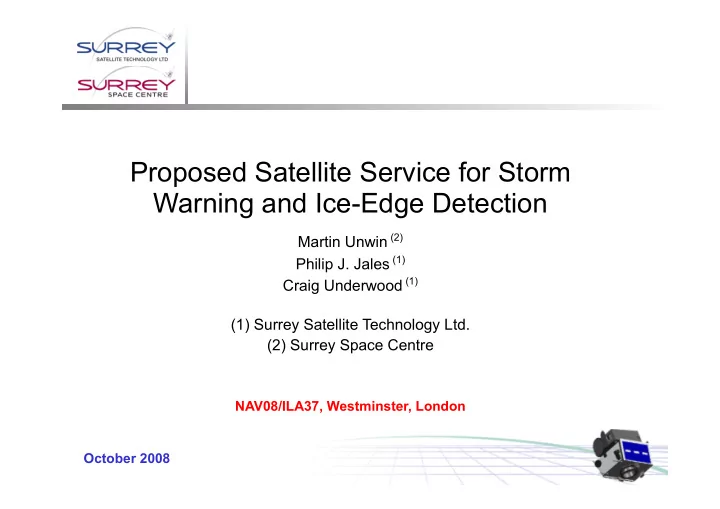

Proposed Satellite Service for Storm Warning and Ice-Edge Detection Martin Unwin (2) Philip J. Jales (1) Craig Underwood (1) (1) Surrey Satellite Technology Ltd. (2) Surrey Space Centre NAV08/ILA37, Westminster, London October 2008
Contents GNSS Reflectometry introduction UK-DMC GPS Reflectometry Experiment Results over Ice & Sea Potential Future Service Ice Edge Ocean Roughness 2
GNSS Reflectometry Satellites in low Earth orbit (LEO) can pick up GNSS signals reflected off the ocean Bistatic arrangement No transmitter on GNSS-R satellite Reflections contain information about surface Potential applications: Ocean roughness Ice monitoring Soil moisture, biomass sensing Flood detection Sea height ... 3
Ocean GNSS Reflections Signal affected by Earth’s rough surface => spreads the signal path-delay and Doppler frequency The signal delay & distortion contain information about the surface Delay: surface height Need dual frequency to measure Distortion: Recover wind / waves Models being developed Single freq. 4
Taking Measurements: Delay Doppler Map Generate Code and Carrier replica Doppler Signal reception when aligned with Doppler frequency and code delay Delay Stepping through these, produces 2D map, similar to radar Weak signal - Integration Delay-Doppler map of BOC (1,1) direct signal (Galileo L1B & L1C – simulated) 5
Example 6
GPS-Reflectometry in-orbit Experiment UK-DMC 100 kg satellite, 2003 First dedicated GNSS reflectometry experiment GPS-R experiment Modified space GPS receiver Medium-gain antenna ~12dBi Data recorder collects 20s of raw data Processed on ground Reflectometry Antenna So far scheduled 80 collections Imager Recovered signals showed link to sea state Planning towards future operational instrument 7
Applications: GNSS Reflections off Ocean 8
GNSS Reflections off Ocean Summary of status Selected for ESA mission SMOSops Collections Modelling methods Output related to mean square slope Application Rapid production of ocean roughness Storm warning 9
Ocean reflection using Galileo First collection of Galileo signal reflection, November 2007 Direct signal Ocean reflected signal acquired and tracked Coherent addition of L1B and L1C signals 10
Exploring Applications: GPS Reflections off Ice 11
GPS Reflectometry over Antarctic Ice January 2008 Images: NASA, Polar View, Google Earth 12
GPS Reflectometry over Antarctic Ice PRN13 PRN13 Signal power PRN10 Envisat ASAR 3 day mosaic, Polar View 13
Sensing polar ice Polar ice data products: Ice edge info Resolution 20km due to code selection But data suggests two orders better is possible (~400 metres) New wideband frequencies will increase resolution Ice height mapping L-band penetrates snow for mapping of the ice surface 14
Current State-of-Art Existing Services Radiometers DOD SSMI – 20 km rsln, daily To be replaced by NPOES NASA AMSIR – 10 km rsln, daily Envisat GM SAR Data – 2 days (when active) Niche for service Higher resolution, more measurements Potential of 400 metre or better with new signals Coverage increases with number of satellites 15
Service Provision: Storm Warning & Ice Edge 16
Satellite and Instrument Design Instrument is 2 kg < 10 Watts Antenna is 12 x 30 cm Reduction may be possible Data rate low Dedicated satellite could be very small Multiple satellites on each launch or Instrument of opportunity (LEO) DMC satellites – 5 satellites coordinated by SSTL Orbcomm – SSTL is preparing to deliver 19 GPS receivers for Orbcomm-2 Iridium has 66 satellites – offering to carry remote sensing instrumentation (780 km, 86.4 deg, 6 planes) 17
Coverage Coverage requirements differ from sea to ice Over Sea: Stationarity (spatial correlation) varies with latitude. Preliminary assumption: 100km, 2 hour requirement Over ice: Lower temporal requirement, but higher spatial requirement Weekly update – covered to x km resolution? Measurements per day per 100x100km box Simulation: instrument on 12 Iridium satellites; GPS constellation; Receive +/-40 degrees from Nadir 18
Coverage Simulation of coverage e.g. instrument on 12 Iridium comm sats GPS constellation 31 satellites Receiver antenna +/-40 degrees from Nadir Coverage calculation: 19
Future Challenges 20
System Challenges Modelling and inversion Measurement potential, accuracy characterisation Calibration / Validation Gaps in measurements using just GPS More coverage from also using Galileo, GLONASS, COMPASS & SBAS systems Data dissemination means Demonstrator mission required 21
Conclusions GNSS Reflectometry technique offers potential for a new marine and ice measurement service Challenge: demonstrate performance Ocean roughness Ice edge resolution Challenge: to distribute data as a service User needs and requirements to be collated Instrument development underway and demonstration on forthcoming satellite 22
Thank you! Any questions? Philip Jales p.jales@surrey.ac.uk Surrey Space Centre Tycho House 20 Stephenson Road Surrey Research Park Guildford, Surrey, GU2 7YE Tel: +44 (0)1483 803974 Fax: +44 (0)1483 803804 23
Recommend
More recommend